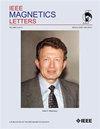Spintronic Neuron Using a Magnetic Tunnel Junction for Low-Power Neuromorphic Computing
IF 1.1
4区 物理与天体物理
Q4 ENGINEERING, ELECTRICAL & ELECTRONIC
引用次数: 0
Abstract
This letter presents a novel spiking artificial neuron design based on a combined spin valve/magnetic tunnel junction (SV/MTJ). Traditional hardware used in artificial intelligence and machine learning faces significant challenges related to high power consumption and scalability. To address these challenges, spintronic neurons, which can mimic biologically inspired neural behaviors, offer a promising solution. We present a model of an SV/MTJ-based neuron that uses technologies that have been successfully integrated with CMOS in commercially available applications. The operational dynamics of the neuron are derived analytically through the Landau–Lifshitz-Gilbert–Slonczewski equation, demonstrating its ability to replicate key spiking characteristics of biological neurons such as response latency and refractive behavior. Simulation results indicate that the proposed neuron design can operate on a timescale of about 1 ns, without any bias current and with power consumption as low as 50利用磁隧道结的自旋电子神经元实现低功耗神经形态计算
这封信介绍了一种基于组合自旋阀/磁隧道结(SV/MTJ)的新型尖峰人工神经元设计。用于人工智能和机器学习的传统硬件面临着与高功耗和可扩展性有关的重大挑战。为了应对这些挑战,自旋电子神经元提供了一种很有前景的解决方案,它可以模仿受生物启发的神经行为。我们介绍了一个基于 SV/MTJ 的神经元模型,该模型采用的技术已在商业应用中成功与 CMOS 集成。我们通过 Landau-Lifshitz-Gilbert-Slonczewski 方程分析推导出神经元的运行动力学,证明它有能力复制生物神经元的关键尖峰特性,如响应延迟和折射行为。仿真结果表明,所提出的神经元设计可以在约 1 ns 的时间尺度上运行,无需任何偏置电流,功耗低至 50 ${\mu }$W。
本文章由计算机程序翻译,如有差异,请以英文原文为准。
求助全文
约1分钟内获得全文
求助全文
来源期刊

IEEE Magnetics Letters
PHYSICS, APPLIED-
CiteScore
2.40
自引率
0.00%
发文量
37
期刊介绍:
IEEE Magnetics Letters is a peer-reviewed, archival journal covering the physics and engineering of magnetism, magnetic materials, applied magnetics, design and application of magnetic devices, bio-magnetics, magneto-electronics, and spin electronics. IEEE Magnetics Letters publishes short, scholarly articles of substantial current interest.
IEEE Magnetics Letters is a hybrid Open Access (OA) journal. For a fee, authors have the option making their articles freely available to all, including non-subscribers. OA articles are identified as Open Access.
 求助内容:
求助内容: 应助结果提醒方式:
应助结果提醒方式:


